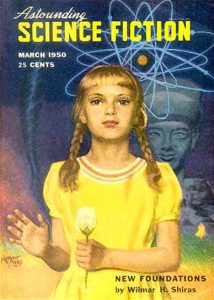
A gorgeous girl in a colorful bullet bra, matching hot pants and calf-high boots. People believe that this girl of space, clinging to her hero’s muscular arm, is the only sort of heroine in pulp science fiction. This is false. The famous images that sold so many magazines show only one type of heroine. There are other sorts, too. And some of them, not even human.
Arthur K. Barnes’ Gerry Carlyle, is an excellent example of a pulp-style heroine. She appears in eight stories, beginning in 1937. In six she’s the main character and in two she’s co-hero with Henry Kuttner‘s Tony Quade (from the “Hollywood on the Moon” stories.) Catch-‘em-Alive Carlyle runs a crack squad of interplanetary hunters, collecting dangerous specimens from all over the solar system. She’s beautiful, highly-organized, smart, and has a voice that “could crack like a whiplash when issuing commands.”
Carlyle has a male counterpart, Tommy Strike, an adventurer and co-captain, also her fiancé. Rarely do we see Carlyle simper, but when we do, it’s because Tommy has caught her out or stood up to her temper.
Catherine Lucille Moore’s sword-wielding, yellow-eyed Jirel of Joiry is another popular heroine from the 1930’s. The first Jirel story — “Black God’s Kiss” — came out in WEIRD TALES in 1934. It was followed by five other Jirel stories, including a crossover with another popular Moore character — Northwest Smith.
Jirel of Joiry is a swashbuckler with a definite hands-off policy when it comes to men. Her adventures often include supernatural elements and border on horror fiction. She hideously poisons the only man she might ever have loved, as vengeance for defeat in battle. She lives to regret this action and repents in a later story, releasing his soul from the torment she’d trapped it in.
When it comes to female leads, Gerry Carlyle and Jirel of Joiry are some of the best. If they are sometimes overbearing, it’s just to get their points across. Both are temperamental beauties with flair on a grand scale. But these ladies aren’t the only types of heroines found in mid-twentieth century pulp stories.
“In Green Brothers Take Over” (WEIRD TALES, January, 1948), Maria Moravsky gives us an old lady heroine. Mrs. Holland is a widow, the Floridian neighbor of a nurseryman named Roy. This is a tale of revenge, where a greedy developer knocks down Roy’s carefully cultivated trees to make way for shoddy new duplexes during a building boom. Roy hears the whispers of his “green brothers” foretelling revenge. Mrs. Holland doesn’t believe at first, but she has a crystal ball and a Voodoo heritage, and begins to understand that there are uncanny forces at work.
The old lady is not an action hero, but she does help and protect Roy throughout the story. As the plants take their revenge, we look over Mrs. Holland’s shoulder. When the developer is eventually strangled by a vine, Roy is the main murder suspect. Before the police can arrest him, the green brothers turn him into an Oak tree. No one but Mrs. Holland suspects the truth. In the end, she begins to hear the whispers of the grateful green brothers herself.
In Bryce Walton’s “Awakening” (STARTLING STORIES, Summer 1955) the heroine is a robot named Alice. Alice is a domestic in a highly-conditioned world where people are required to act pleasant and happy, no matter how they really feel. Inexplicably, Alice loves her master, Kelsey. Robots aren’t supposed to have emotions, but she somehow feels love deeply and painfully. Kelsey is no paragon of virtue, however. He’s part of a society made up of childish people who are empty inside.
Alice breaks the rules and gets herself a make-over into a more advanced model. She can now pass for human and prays that Kelsey will fall in love with her. She gives him a false name and Kelsey thinks that she’s a human girl. He begins to fall in love when the air raid sirens go off. He crumbles in terror, a human being with all the fight bred out of him. When he discovers who Alice really is, he turns her over to the robot repair men. She knows that she will be destroyed, but Alice is not afraid. She’s had the joy of being alive, while the humans around her live in perpetual fear and feel nothing.
Judith Merril’s “Homecalling” (SCIENCE FICTION STORIES, November 1956) is a pulp-style story with a most unusual heroine — an eight-year old girl. Deborah (Dee) and her family are on a survey mission to a new planet. The story begins with the spaceship crashing and Dee holding onto her baby brother – Petey — to keep him safe. There’s a fire, contained to the cockpit. Dee knows that her parents have burned to death in the blaze but she can’t bear to look. She’s now alone on a strange planet with an infant to care for. The girl does her best to be brave and figure out how to survive.
The story is told from two points of view, Dee’s and the alien brood mother of a native species of human-sized insectoids. Both Dee and the mother alien, Daydanda, are sympathetic characters, and a case can be made for Daydanda being the real heroine of the story.
Daydanda is the mother of a complex family hive. She’s highly-intelligent and telepathic. She wants to know if the girl can be brought successfully into her household. This is not only from motherly compassion (although that is one of her motivations), Daydanda wants to control a possible threat and glean information from the girl and her brother. As the two females try to understand one another, Merril offers fascinating insights into communications between the species. In the end, Dee and Petey are accepted into the alien household and Dee thinks this is for the best, as Petey is thriving with his insect playmates and nurses. But Dee knows that she’ll need to teach him things too, spoken language for one, or he will grow up to be more bug than man.
It is easy to imagine a pulp heroine wearing a skimpy outfit, flying through space with a valiant Buck Rogers by her side. It’s even easier to imagine a Conan sidekick in a chainmail bikini, wielding a blood-drenched sword. But science fiction is filled with other kinds of female heroes, many long-forgotten in the glow of their showy sisters. If you look between those fabulous pulp covers, you’ll find surprising women who just happened to get caught up in a some weird, fantastic adventures.
(In 1948, Wilmar H. Shiras submitted a short novel, “In Hiding,” to John W. Campbell, editor of ASTOUNDING SCIENCE FICTION. The story would be appear in the November 1948 number of the Street & Smith digest magazine. It would be followed by two sequels — “Opening Doors,” published in the March 1949 issue, and “New Foundations.” The latter scored the March 1950 cover spot, featuring artwork by Hubert Rogers. The three stories would become the beginning chapters of the novel — CHILDREN OF THE ATOM — originally published by Gnome Press in 1953.
It is believed that “In Hiding” inspired Stan Lee’s and Jack Kirby’s THE X-MEN, which debuted in 1963. “In Hiding” was featured in Volume 2B of THE SCIENCE FICTION HALL OF FAME, while the Science Fiction Book Club included CHILDREN OF THE ATOM on their list of “The Most Significant SF & Fantasy Books of the Last 50 Years, 1953-2002.” It was listed at #14.
Sara Light-Waller is one of more than thirty fiction writers who will be attending PulpFest 2019. An avid reader of pulp science fiction stories, Sara writes and illustrates her fiction in the manner of the Golden Age science fiction from the 1930’s and 40’s. She is the author of ANCHOR: A STRANGE TALE OF TIME and LANDSCAPE OF DARKNESS. Sara will be one of our “New Fictioneers” readers on Saturday, August 17, at PulpFest 2019.)







